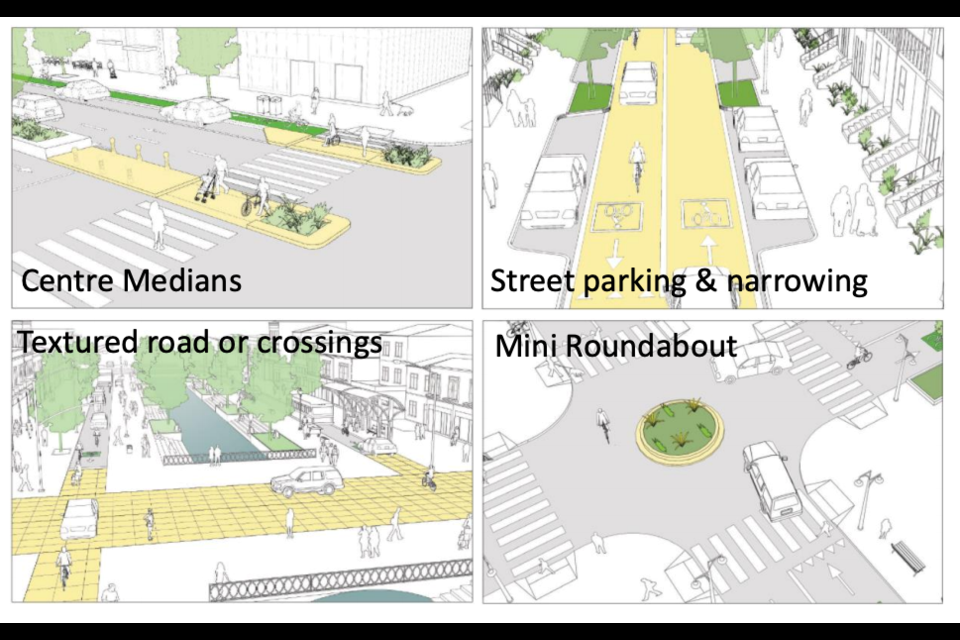Are you concerned about traffic speeds in your neighbourhood?
A new policy passed at Collingwood council on Monday night has set out a new set of steps residents must take if they’d like the town to consider investigating implementing traffic calming in local neighbourhoods.
However, some concerns were raised about the implications of such a policy and who had been consulted on it.
While a motion to defer put forward by Coun. Yvonne Hamlin to give time for the accessibility committee and the active transportation and trails committee to provide comments on the new policy was defeated, Coun. Tina Comi said she thought it was important those committees be consulted on the plan.
“I am strongly of the opinion that traffic calming, of course, is interwoven into both our climate emergency and sustainability efforts,” said Comi, also pointing to accessibility as a key factor. “To me, it shows how far we have to go with our entire understanding of how this all intersects together.”
As a result, Comi indicated she would not be in support of the traffic calming policy, citing the residents who had reached out to her on the issue.
“I don’t see what they’re looking for in this particular policy,” she said.
According to the new policy, there are eight steps that must occur for traffic calming measures to be installed in a neighbourhood:
- A formal request with a petition including 51 per cent or more of those living on the street must be received supporting traffic calming measures.
- Following a successful petition and initial screening, the road in question must meet five criteria: It must be considered a local road (collector roads could qualify on a case-by-case basis), it must have a daily average traffic volume of 900 vehicles, be at least 220 metres long without stop signs or traffic signals, have a grade below six per cent, and cannot have been part of a traffic calming request in the last five years. If those requirements are met, staff will conduct a speed survey.
- Data collection to study traffic volume, collision records, pedestrian activity, and site-specific information.
- Creating a preliminary design that would be reviewed by emergency services, transit, and town operations for review and comment.
- Notify the community and share the preliminary designs.
- Prioritize all the locations that have qualified to this point based on the budget allocated for traffic calming work.
- Build and install the traffic calming measures with notices sent to local residents and posted publicly.
- Monitor and evaluate the effectiveness of the measures and the impact on the surrounding road network.
The policy states the exact traffic calming measures implemented in an area would be determined on a case-by-case basis and could include speed humps, speed cushions, extending curbs to narrow an intersection or create an s-shaped curve on a street, installing centre medians, using a mini roundabout in an intersection to slow through traffic, adding on-street parking and non-physical measures such as pavement markings, signage, and increased speed enforcement.
When getting into specifics, Comi said she took issue with part of the policy that a formal request including a petition with 51 per cent of resident signatures be the first step to requesting traffic calming measures for any neighbourhood.
“What will it be like to be the single person on a street to go door-to-door saying that you have a problem and you can’t solve it unless 51 per cent of your neighbours agree and to put your face to that? We don’t even require that when reporting bylaw matters,” said Comi. “Here, we’re singling somebody out.”
Coun. Deb Doherty said she would have liked to see some analysis in the report of streets that should be considered right away for traffic calming measures. She also echoed Comi’s comments concerning the accessibility committee and the active transportation and trails committee being consulted on the policy as a whole.
Peggy Slama, the town's Director of Public Works, Engineering and Environmental Services, said those committees would be consulted on requests as part of the eight-step process.
Coun. Kathy Jeffrey said she thought the traffic calming policy as presented was a good start.
“I think, through this policy, we’re trying to be consistent yet flexible in trying to respond to each street and its demographics. We have to start somewhere. I’m very happy to start with (this),” she said.
Deputy Mayor Keith Hull asked if the traffic calming policy would preclude any member of the public from providing a deputation to council on traffic calming in their neighbourhood, or a member of council bringing forward a motion to institute traffic calming in a specific area.
Clerk Sara Almas said it would not.
“I’m done reading emails. I’m going to bring forward a recommendation or request of staff that we deal with Findlay Street,” said Hull.
Mayor Brian Saunderson asked that staff come back on an annual basis to report on the policy so council can evaluate if changes should be made to the policy on an ongoing basis, which was passed unanimously as an amendment.
Council voted in favour of implementing the traffic calming policy by a vote of 8-1 with Comi voting against.
A part of the motion was severed which gave the director of public works authority to accept or reject requests. Council voted in favour of that part of the motion as well, by a vote of 6-3, with Comi, Coun. Deb Doherty and Coun. Bob Madigan voting against.

